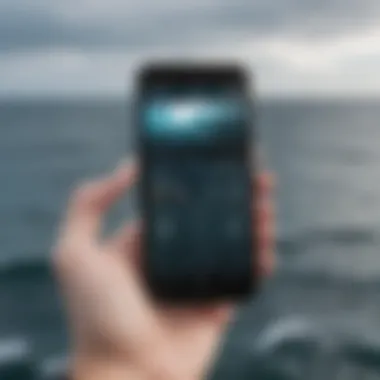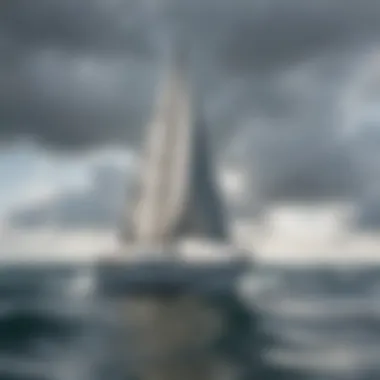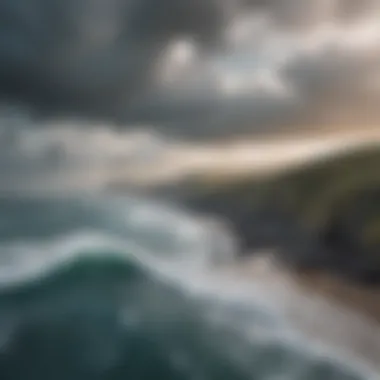The Impact of Ocean Forecast Apps on Marine Activities


Intro
The intersection of technology and marine activities has evolved significantly in recent years. Ocean forecast applications have become indispensable tools for various stakeholders, from recreational boaters to professional fishermen and researchers. These applications offer a range of functionalities aimed at improving safety and decision-making in unpredictable ocean environments.
In this article, we will explore how these apps have transformed the maritime landscape, examining their core features, advantages, and the technological advancements that have facilitated their rise. The implications of these innovations for different user groups will also be sectioned. By understanding the current state and future potential of ocean forecast apps, users can better navigate the complexities of marine ventures.
Preface to Ocean Forecast Apps
Ocean forecast apps are becoming vital tools in various marine activities. They provide necessary information that assists users in making informed decisions while at sea. With the rise of recreational boating, fishing, and other oceanic activities, the need for accurate ocean forecasts has become more crucial than ever.
Definition and Purpose
Ocean forecast apps are applications designed to provide users with real-time weather data, ocean conditions, and specific forecasts relevant to marine activities. Their primary purpose is to enhance safety and decision-making for both recreational and professional mariners. By analyzing various data sources, these apps deliver tailored forecasts that consider local water conditions, currents, tides, and weather patterns. For a boat owner or fisherman, such information is not merely beneficial but essential for optimizing their time on the water and ensuring safe navigation.
Historical Context
Historically, mariners relied on traditional methods for weather predictions. Fishermen and sailors turned to charts and navigational skills that had been passed down through generations. As technology progressed, the introduction of satellite imagery and computational models revolutionized weather forecasting. In the early 2000s, mobile technology began to emerge, leading to the development of the first ocean forecast applications. These early versions may not have been as robust as today’s offerings but laid the groundwork for future innovations. As smartphones became more prevalent, the accessibility and functionality of these apps significantly improved, changing how people interact with and rely on environmental data.
Key Features of Ocean Forecast Apps
Understanding the key features of ocean forecast apps is crucial for highlighting their significance in modern marine activities. These applications serve a pivotal role by providing users with a wealth of information critical for navigational safety and planning. The ability of these apps to deliver accurate and timely forecasts directly impacts decision-making, particularly for mariners, fishermen, and recreational water sports enthusiasts. Below are some vital features that contribute to the utility of ocean forecast apps.
Real-time Data Access
Real-time data access is of utmost importance for any ocean forecast app. Users require immediate updates on weather conditions, tide schedules, and water currents. For example, apps like Windy or Fishbrain provide users with essential data that can affect their activities on the water. These figures include temperature, wind speed, and wave height, all updated frequently.
The immediacy of this information ensures that users can make decisions based on the environment they are experiencing right now. The inclusion of real-time alerts for severe weather conditions is another significant aspect that enhances user safety. This feature can literally be the difference between a safe outing or a potentially dangerous situation at sea.
User-friendly Interface
A user-friendly interface cannot be overlooked when discussing ocean forecast apps. Even with the most sophisticated features, an app will not be effective if users cannot navigate it easily. Applications such as NOAA Weather Radar provide intuitive designs that cater to both novice and experienced users. They often feature large buttons, simple graphics, and easily digestible data presentation. This straightforward approach helps users quickly understand essential information without overwhelming them.
Moreover, a clean interface can help users access specific functionalities faster. For example, the ability to switch between different data layers (such as wind maps or temperature readings) with just a tap is a feature highly sought after by everyday users. This simplicity in design reflects the app's purpose: to inform and aid, not confuse.
Customization and Alerts
Customization is another key feature that enhances the functionality of ocean forecast apps. Different users have different needs; therefore, the ability to personalize the app settings can lead to users gaining the most relevant insights. For instance, a surfer may want detailed information about wave height and tides, while a fisherman might focus more on wind direction and water temperature. Apps that allow users to tailor alerts and notifications deliver a highly personalized experience.
This capability can extend to alerting users about specific conditions or changes that matter to them. For example, an angler might set alerts for optimal fishing conditions, while a sailor might wish to be notified of impending storms. These customizable notifications help users stay informed and prepared so they can optimally plan their marine activities.
"Real-time access, a user-friendly interface, and customization turn useful data into invaluable tools for those navigating ocean waters."
Technological Innovations Behind Ocean Forecast Apps
The incorporation of technological innovations has redefined the landscape of ocean forecast apps. These advancements provide essential tools that enhance the accuracy and usability of marine forecasts, which is vital for both recreational and professional maritime activities. As technology evolves, so do the methods of predicting oceanic conditions, which can directly impact safety and planning in marine environments.
Satellite Data Integration
Satellite data integration forms the backbone of modern ocean forecast applications. Satellites collect vast amounts of data regarding sea surface temperatures, wave heights, and wind speeds. This information is crucial for creating accurate forecasts. For instance, data from NASA's MODIS satellite is extensively used to monitor ocean conditions.
The benefits of utilizing satellite data include:
- Wider Coverage: Areas that are not easily accessible can still be monitored.
- Timeliness: Information is updated frequently, ensuring users have the latest data.
- Comprehensive Analysis: Enables forecasters to analyze conditions over large geographic areas efficiently.
The quality of forecasts improves significantly, allowing fishermen, surfers, and commercial shipping companies to make more informed decisions.
Machine Learning Algorithms
Machine learning algorithms contribute substantially to refining the accuracy of ocean forecasts. These algorithms analyze historical and real-time data to predict future conditions effectively. For example, by evaluating past weather patterns against current data, these algorithms can discern trends and anomalies. This predictive capability is invaluable for users relying on timely and precise forecasts.
Important aspects of machine learning in ocean forecasting include:


- Dynamic Learning: Algorithms adapt over time, improving forecast precision.
- Data Management: They process large datasets quickly, providing timely results.
- Higher Accuracy: Significant reduction in errors compared to traditional forecasting models.
The evolving complexity of these algorithms indicates a promising future for ocean forecasts, enhancing user experience and decision-making in uncertain conditions.
Mobile Application Development
The surge in mobile technologies has spurred the development of intuitive ocean forecast apps. Today’s mobile application frameworks are designed to improve accessibility and engagement for users. These apps are equipped with essential features such as push notifications, live updates, and interactive interfaces that engage users effectively.
Key considerations in mobile app development include:
- User-Centric Design: Focus on usability ensures a smooth experience for diverse user groups.
- Cross-Platform Functionality: Allows access across different devices and operating systems, promoting inclusivity.
- Integration of GPS: Users can receive localized forecasts effortlessly, tailored to their specific locations.
The ease of use and immediate access to critical information fosters a culture of safety and preparedness among marine activity participants.
Applications in Recreational Marine Activities
The significance of ocean forecast apps in recreational marine activities cannot be overstated. Such applications provide critical information that directly affects the safety and enjoyment of various water-related pursuits. The forecast apps collect and disseminate vital data about weather patterns, wave conditions, and water temperatures. This timely information helps users to make informed decisions. For recreational activities like fishing, boating, and surfing, having access to reliable forecasts can enhance both the experience and safety of participants.
Key aspects include the benefits of real-time updates and the ability to customize alerts based on user preferences. Moreover, these apps play an essential role in promoting responsible marine practices and encouraging users to respect nature while enjoying their time on the water. In this section, the focus lies on how these applications facilitate fishing and boating as well as surfing and water sports.
Fishing and Boating
Fishing and boating benefit significantly from ocean forecast apps. Accurate tide and sea condition predictions can determine the success of a fishing trip. Enthusiasts rely on these tools to select optimal times for fishing based on tidal changes or weather patterns. Furthermore, knowing wind conditions is crucial for safe boating. Strong winds can make navigating vessels challenging and raise risks for inexperienced boaters.
Some popular ocean forecast apps, like Fishbrain and Navionics, provide functionalities such as:
- Tide Charts: Display tidal information specific to locations for better fishing success.
- Weather Updates: Provide continuous alerts about changes in weather patterns affecting safety.
- Fish Behavior Insights: Include predictions based on environmental factors to assist fishermen in planning their trips.
Access to these tools increases the likelihood of a successful outing, while also ensuring safety. Custom alerts enable users to be promptly notified of changing conditions, allowing quick responses when necessary.
Surfing and Water Sports
For surfers and water sports enthusiasts, ocean forecast apps are indispensable. Surfing conditions depend on wave heights, period, and wind direction. Apps like Surfline and Magicseaweed offer detailed surf forecasts, making them essential for serious surfers. By analyzing swell data, these apps help individuals identify optimal beaches and times for surfing.
Features important to water sports users include:
- Wave Forecasts: Give surf height estimates and ideal wind conditions.
- User Reviews and Reports: Include feedback from other surfers, aiding in real-time decision making.
- Location Recommendations: Suggest the best spots based on current conditions.
Users can monitor conditions from the comfort of their homes before heading out, ensuring they make the most of their time on the water. These apps not only enhance performance but also help users stay safe by avoiding hazardous conditions.
"Accurate forecasting allows sports enthusiasts to plan better and ensure fun and safety alike."
Implications for Professional Maritime Operations
Ocean forecast apps are increasingly crucial in professional maritime operations. Their role enhances safety, efficiency, and decision-making in various contexts. For operators involved in commercial shipping and search and rescue missions, the insights from these applications can translate into significant operational improvements.
Commercial Shipping
The maritime shipping industry operates within a complex environment. Factors such as weather conditions, ocean currents, and navigation routes can heavily influence a vessel's journey. Ocean forecast apps assist shipping professionals by providing real-time data, helping to mitigate risks associated with adverse weather and assisting in route optimization. A vessel, for example, can avoid rough seas, projected storms, or icebergs by adapting its path according to updated forecasts. This adaptability can save time, reduce fuel consumption, and lower costs, all while improving safety for crew and cargo.
By adopting these apps, companies can also enhance their overall operational resilience. Accurate forecasts help shipping fleets stay informed about port conditions and maritime traffic, which is vital for timely deliveries and effective supply chain management.
"Integrating ocean forecast apps into commercial shipping strategies helps companies increase accountability and reduce economic risks."
Search and Rescue Operations
In search and rescue operations, every second counts. These apps provide vital information that assists emergency responders in locating individuals or vessels in distress. By utilizing geospatial data and predictive analytics, these applications can identify the most likely areas where a search might yield results, optimizing resource allocation.
Moreover, accurate forecasting of wave heights, wind speeds, and tide patterns contributes to crafting effective rescue strategies. Search and rescue teams can better gauge the conditions they may face and prepare accordingly. This preparedness can potentially save lives and minimize the risks faced by rescue personnel themselves.
Environmental Assessments and Ocean Forecast Apps


Ocean forecast apps play a crucial role in environmental assessments by providing reliable data that informs various stakeholders. These applications collect and analyze oceanographic data, which is essential for understanding the health and dynamics of marine ecosystems. Accurate forecasting is valuable not only for recreational users but also for scientists, environmental organizations, and policymakers. With real-time data, forecasts help in evaluating environmental changes and making informed decisions that affect marine conservation.
Role in Data Collection
One of the primary functions of ocean forecast apps is their ability to collect extensive data from various sources. These sources include satellite imagery, buoy data, and underwater sensors. The data collected can include temperature, salinity, water currents, and wave heights. By integrating this data, apps help to form a comprehensive picture of marine conditions.
The implications of this data collection are significant. Researchers can track changes in ocean temperature, which affects marine life and ecosystems. For instance, higher temperatures can lead to coral bleaching, while shifts in currents can influence fish migration patterns. Accurate data collection allows scientists to build predictive models, which are vital for forecasting environmental events
Impact on Marine Conservation
The impact of ocean forecast apps on marine conservation efforts is profound. These tools provide essential data that aids in the protection of marine habitats. For example, specific forecasts can alert conservationists about harmful algal blooms, which can be detrimental to marine wildlife and water quality.
Moreover, real-time data helps in monitoring protected marine areas. Conservationists can assess the effectiveness of policies and strategies designed to safeguard marine environments. Understanding changing ocean conditions through these apps allows agencies to adapt their approaches to conservation effectively.
Ocean forecast applications, thus, serve as invaluable resources for enhancing marine preservation. They empower stakeholders with the knowledge needed to advocate for sustainable practices and policies.
"The integration of technology in marine assessments has transformed how we approach conservation efforts."
In summary, ocean forecast apps represent significant advancements in environmental assessments. By offering real-time data collection and insights that affect marine conservation, they have become indispensable tools in the ongoing effort to understand and protect our oceans. Users are empowered to make better decisions that consider both human activity and ecological health.
Challenges and Limitations
Understanding the challenges and limitations of ocean forecast apps is essential for both users and developers. This section aims to provide a clear insight into the complexities surrounding data accuracy and technological barriers. Identifying these issues can help mitigate risks and improve user experiences in marine activities.
Data Accuracy
Data accuracy is crucial for the reliability of ocean forecast apps. These applications provide critical information about weather conditions, wave heights, and water temperatures, which influence decisions made by recreational sailors and professional mariners. Even minor discrepancies can lead to serious consequences, such as navigating unsafe waters or scheduling fishing trips during storms.
Moreover, the integration of various data sources, such as satellite imagery and buoy monitoring, can cause variations in accuracy. Satellite data is often updated less frequently than on-the-ground measurements, which might not reflect sudden environmental changes. Users should be aware that certain apps may prioritize specific data sources over others. This can create inconsistencies in reported conditions.
Developers of ocean forecast apps must constantly enhance algorithms and data validation processes. This means utilizing advanced technologies and real-time data collection. Continuous improvement in data analysis and synthesis can help to enhance reliability.
Technological Barriers
Technological barriers present another significant challenge for ocean forecast apps. Users must be familiar with the app's interface, features, and functionality to utilize them effectively. A steep learning curve can deter many from fully harnessing the app's capabilities.
Furthermore, these technologies depend on reliable internet connectivity. In remote areas, this might not always be feasible. Users can find themselves unable to access real-time data when they need it the most.
Other potential technological barriers include compatibility issues with different devices. Some apps may not function optimally across all operating systems, leading to frustration for users. Developers should prioritize user experience and consider these factors to create more inclusive and accessible applications.
The challenge of cybersecurity also looms. As dependence on mobile apps grows, so does the risk of data breaches or hacking attempts. Developers must stay ahead of potential threats and ensure apps are secure to protect user data and maintain trust.
Ultimately, recognizing Challenges and Limitations enables users to make informed choices and encourages developers to strive for continuous improvements. This can help optimize marine activities and enhance safety on the water.
Future Trends in Ocean Forecast Technology
The landscape of ocean forecasting is in constant evolution, influenced by technological advancements and changing user needs. As we look towards the future, ocean forecast apps are expected to integrate more complex technologies and features that enhance their usability and effectiveness. Understanding these trends is vital for stakeholders in marine activities, ensuring they stay informed and prepared to adapt.
Integration of Internet of Things (IoT)
The Internet of Things (IoT) is reshaping various industries, and marine forecasting is no exception. IoT enables real-time data collection from various sensors deployed in oceans and along coastlines. These sensors can monitor parameters like water temperature, wave height, and salinity. When integrated into ocean forecast apps, this data allows for more accurate and timely predictions.
Benefits of IoT Integration:
- Enhanced Data Accuracy: Real-time data updates reduce discrepancies and improve the reliability of forecasts.
- Personalized User Experience: Users can receive tailored forecasts based on their location and preferred activities.
- Rapid Response Capability: Immediate insights can facilitate faster decision-making, crucial for safety in marine environments.
However, the challenges of IoT implementation, including connectivity issues in remote areas and data security, need to be addressed. The success of this integration relies on robust infrastructure to support the influx of data generated by millions of devices.
Sustainability Efforts
Sustainability has become a significant concern in various industries, including marine activities. Ocean forecast apps are beginning to incorporate features that align with environmental sustainability goals. These apps help users understand the impact of their activities on marine ecosystems.


Key Aspects of Sustainability in Ocean Forecast Apps:
- Eco-Friendly Navigation Alerts: Applications can notify users of sensitive areas or times when marine life is particularly vulnerable, guiding their activities to minimize disruption.
- Conservation Partnerships: Many apps partner with organizations focused on marine conservation, providing users with information about ongoing efforts and how they can contribute.
- User Education: Apps are increasingly educating users on responsible practices and the significance of preserving marine environments.
Through these sustainability efforts, ocean forecast apps not only serve the needs of the users but also contribute to the broader goal of maintaining healthy oceans.
"The future of ocean forecasting lies not only in technology but also in fostering a culture of responsibility among users."
As the integration of these trends continues to advance, ocean forecast apps will become more essential tools for both recreational and professional maritime stakeholders, ensuring they can navigate their activities with confidence and care.
Comparative Analysis of Popular Ocean Forecast Apps
The comparative analysis of popular ocean forecast apps is essential in understanding their roles and effectiveness in marine activities. Each application offers distinct features and functionalities tailored to various user needs. By examining these apps side-by-side, users can make informed decisions based on their specific requirements, whether they are recreational users, commercial mariners, or environmental researchers. This analysis allows users to prioritize what is most important for their marine activities, such as accuracy of forecasts, real-time updates, or user interface design.
Feature Set
When exploring the feature set of ocean forecast apps, it becomes clear that not all applications are created equal. Various factors influence the attractiveness of an app. Key elements include:
- Real-time data updates: This feature ensures users have access to the most current conditions. Apps like Windy and PredictWind excel in offering timely wind and wave data.
- User interface: A clean and intuitive interface enhances user experience. Apps such as Navionics stand out for simplicity and ease of navigation.
- Custom alerts: Some apps allow users to set notifications for specific weather conditions to enhance safety during activities. For instance, SailFlow offers customizable alerts tailored to sailing conditions.
Understanding these features can help users select an app that best fits their needs, ensuring effective planning and safer experiences at sea.
User Reviews and Ratings
Evaluating user reviews and ratings is pivotal in assessing the popularity and reliability of various ocean forecast apps. User feedback often reflects real-world experiences and can illuminate hidden advantages or disadvantages of an app. Key aspects to consider include:
- Satisfaction levels: High ratings in app stores often indicate user approval. Apps like NOAA Weather Radar regularly receive positive reviews for their accuracy and comprehensive features.
- Common complaints: Feedback can reveal issues such as bugs or poor customer support. Users may highlight problems they faced while using an app, providing insights that help potential users make more informed decisions.
- Update frequency: Reviews can mention how often developers release updates. Consistent updates can signify that the developers are committed to improving user experience, which can be crucial for any technical application.
"User reviews play an important role in the adoption of ocean forecast apps. They can tip the scales in favor or against an application based on firsthand experience."
User Adoption and Behavior Patterns
Understanding user adoption and behavior patterns in ocean forecast applications is critical to evaluating their impact on marine activities. The way users interact with these apps reveals their needs, preferences, and the challenges they face. As more people turn to technology for information, it becomes essential to analyze who these users are and how they engage with ocean forecast data.
Demographics of Users
The user base of ocean forecast apps is diverse, encompassing various demographics. Primarily, recreational boaters and fishermen constitute a substantial portion of users. This group includes both novices and seasoned professionals who rely heavily on precise forecasts to ensure safety. On the other hand, commercial operators and researchers also use these applications to analyze marine conditions for operational efficiency.
Age is another significant factor. Younger individuals, particularly millennials and Gen Z, are often more inclined to use these apps due to their comfort with technology. They prefer apps with intuitive designs and immediate access to data. Conversely, older users may favor more traditional methods but are increasingly adopting mobile solutions as they become aware of their benefits. Understanding these demographic trends can help developers tailor applications to better meet user needs and improve overall engagement.
Trends in User Engagement
User engagement with ocean forecast apps is gradually evolving. Research indicates that users seek more than just basic forecasts; they desire dynamic content that matches their activities. For instance, surfers may engage deeply with wave height and wind projections, while powerboaters might focus on real-time wind speeds and tide charts.
Moreover, the integration of social features has started to influence user behavior. Apps that allow users to share conditions or track their trips enhance connectivity among users. It fosters a community atmosphere that can encourage more frequent app usage.
In summary, the patterns of user adoption and behavior in ocean forecast apps indicate a growing reliance on technology and data. Understanding these patterns not only aids developers in improving features but also enables stakeholders to use this information to make informed decisions in marine activities.
"Analyzing user demographics and engagement trends is crucial for optimizing ocean forecast applications to serve diverse marine activities effectively."
By enhancing the app features to accommodate specific user needs, developers can foster greater user satisfaction and promote safer marine practices.
Closure: The Future of Ocean Forecast Apps
As we look ahead, the future of ocean forecast apps appears promising yet complex. These applications have become essential tools in marine activities, providing accurate data and insights that significantly impact safety and decision-making. The necessity for reliable ocean forecasts stems from the growing diversity of marine activities such as commercial shipping, recreational boating, and environmental monitoring. Understanding how these tools will continue to evolve is crucial for users from all sectors.
Summary of Key Insights
Ocean forecast apps have transformed how we interact with marine environments. They offer real-time data access, an intuitive user interface, and customizable alerts that empower users to make informed decisions on the water. Their integration of advanced technologies like satellite data and machine learning enhances predictive accuracy, helping users anticipate changes in sea conditions. Furthermore, the rising emphasis on environmental conservation has reinforced the role of these apps in data collection and marine research.
In essence, the combination of technological innovation and user-centric design positions ocean forecast apps as invaluable resources for both professional mariners and recreational users.
Call for Further Research
Despite the advancements, there remain many areas that require more exploration. Issues about data accuracy persist, demanding ongoing research into better algorithms and more precise forecasting methods. As the field of marine technology grows, further studies could identify new applications and integrations, such as partnerships with environmental agencies or the incorporation of IoT devices.
The challenges posed by technological barriers and varying access to data must also be addressed. Future research should aim to make these tools more accessible to a broader audience, particularly in underprivileged regions. Enhancing user engagement through educational initiatives may also stimulate interest and increase usage rates.



